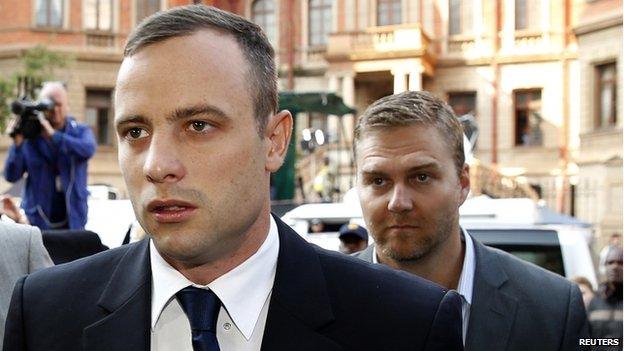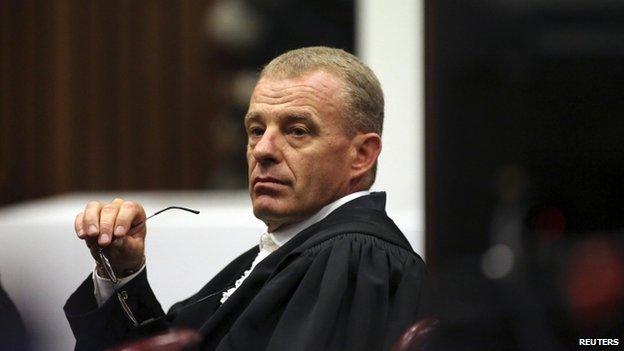Oscar Pistorius damaged but not destroyed
- Published

The past five days of the trial have done Oscar Pistorius few favours
It has been exhausting just to watch Oscar Pistorius - doubled up on the ropes for hour after hour, heavy arms trying to fend off another clinical combination of lethal jabs and low blows from prosecutor Gerrie Nel.
As the athlete finally slinks wearily back across the court from the witness stand to the dock, he must know that the last five days have done him few favours in this trial.
He has been forgetful, evasive, agitated, uncertain, argumentative, and defiantly - some would say deliberately - ambiguous about some of the key issues at the heart of this murder trial. However well his forensic experts proceed to shore up his testimony in the coming days, his credibility has been damaged.
'Buckets of uncertainty'

Prosecutor Gerrie Nel has depicted Oscar Pistorius as a man with a disdainful attitude to authority
Inevitably, many people watching the proceedings are resolutely preoccupied with the facts - and the extent to which Mr Nel has cast doubt - or worse - on Mr Pistorius' explanation of his behaviour the night he killed Reeva Steenkamp.
It is understandable. Facts matter. I have been fending off emails from members of the public anxious to unearth some "smoking gun" detail that can resolve this case once and for all.
A man from the US seemed sure that all would be revealed if only it could be established that Mr Pistorius' alarm panel was stained with blood. A woman sought to assure me women "do not" take their mobile phones to the toilet.
But the reality, from my vantage point in the public gallery here, is that there is no "smoking gun" - besides the obviously literal one.
The truth is something only Mr Pistorius knows, and Mr Nel - for all his flamboyant scepticism, disorientation skills, and razor-edged logic - has succeeded only in muddying the waters.

The trial has many elements which have captivated the public including a celebrity killer and a beautiful victim
Yes, he has cast buckets of rank uncertainty on the athlete's slumped shoulders. But he has not yet proved beyond all doubt, to my mind, that Mr Pistorius' version "cannot be" - to borrow one of the favourite put-downs of defence lawyer Barry Roux.
Instead, what we are left with is something much more mercurial - and much more compelling.
There are plenty of reasons why this trial has fascinated so many members of the public. A celebrity killer. A beautiful victim. A country often preoccupied by violence. But I suspect that at least part of the fascination is the enduring mystery that lurks at the heart of this trial… and the simple, but perhaps unknowable, question: "What was Mr Pistorius thinking when he pulled that trigger?"
In court, under Mr Nel's ruthless gaze, the Olympic sprinter has tried out half a dozen different versions of an answer - from an accident, to a blameless and unthinking instinct, to a deliberate but non-lethal tactic, to a chance combination of an uncertain aim and a nervous trigger-finger.
Those lawyerly, guilt-evading answers do not seem to have impressed many people.
Seed of doubt?
As I outlined in an earlier blog, Mr Pistorius has some reason to embrace ambiguity. He knows that he could be cleared of deliberately killing Reeva Steenkamp, but still be found guilty of intentionally murdering "someone" behind a closed door.
The other issue that has preoccupied me as I have watched Mr Pistorius in the witness box is the timeline of his "mistake." It is a word that he and his family constantly use. But I'm not talking about the few seconds prior to the shooting; rather the months and years before hand.
Mr Nel has built up a powerful portrait of a man with a disdainful attitude to authority, an occasionally aggressive attitude to women, and an extraordinarily entitled and reckless attitude to the pistol he carried with him absolutely everywhere, often cocked.
As Mr Pistorius reflects on the last few days, traumatised as he clearly already is, will he - as he appeared to do in the dying moments of his cross-examination when he resolutely refused to accept "blame" for Ms Steenkamp's death - stick to his belief in his own, ultimate innocence on all these charges? Or has a seed of doubt been sown about the life and the assumptions that led him to this place?
To borrow from a great Russian novel: "If he has a conscience, he will suffer for his mistake."
-
×
-
1. Balcony
×
Mr Pistorius said in his statement at the start of the trial that he woke in the early hours and walked on his stumps to the balcony, pulled in two fans, closed the sliding door and drew curtains. He said that shortly before he had spoken to Reeva, who was in bed beside him.
He said he rejected prosecution claims that a witness heard arguing coming from the house before the shooting.
-
2. Bathroom window
×Mr Pistorius said he heard the bathroom window sliding open and believed that an intruder, or intruders, had entered the bathroom through a window which was not fitted with burglar bars.
"Unbeknown to me, Reeva must have gone to the toilet in the bathroom at the time I brought in the fans," he said.
Mr Pistorius said he approached the bathroom armed with his firearm, to defend himself and his girlfriend, believing Ms Steenkamp was still in bed.
-
3. Shooting
×Both sides agree four bullets were fired. Ms Steenkamp was hit three times.
Mr Pistorius said he fired his weapon after hearing a noise in the toilet which he thought was the intruder coming out of the toilet to attack him and Ms Steenkamp.
He said he was in a fearful state, knowing he was on his stumps and unable to run away or properly defend himself.
Mr Pistorius said he rejected claims that he was on his prostheses when he shot at the door.
A witness told the trial she woke to hear a woman screaming and a man shouting for help. She said that after the screams she heard four shots.
-
4. Bedroom
×Mr Pistorius said he went back to the bedroom after shooting at the toilet door, still shouting for Reeva. Lifting himself up onto the bed, he felt over to the right hand side of it and noticed Ms Steenkamp was not there.
Mr Pistorius said this was when he realised she could have been in the toilet.
-
5. Toilet door
×Mr Pistorius said he went back to the bathroom but the toilet was locked, so he returned to the bedroom, pulled on his prosthetic legs, turned on the lights before bashing in the toilet door with a cricket bat.
Forensics expert Johannes Vermeulen told the court that the height of the marks on the door caused by the cricket bat suggest Mr Pistorius was on his stumps at the time.
-
6. Emergency calls
×Mr Pistorius's defence team say he then called security at the gated housing complex and a private paramedic service before carrying Ms Steenkamp downstairs.
A security guard claimed it was the other way round, and he had called Mr Pistorius first after reports of gunfire. However, phone records shown to the court revealed Mr Pistorius called the estate manager at 3:19am, a minute later he called the ambulance service and at 3:21am he called estate security.
A minute later he received an incoming call - estate security calling him back.
According to police phone expert Francois Moller, Mr Pistorius called his friend Justin Divaris a short time later and just after 4:00am he called his brother Carl.
